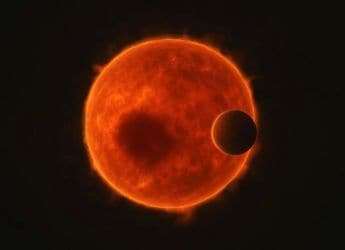- Home
- Science
- Science News
- James Webb Spots Bizarre Planet Forming Disk Full of Carbon Dioxide
James Webb Spots Bizarre Planet-Forming Disk Full of Carbon Dioxide
JWST detected a carbon dioxide-rich planet-forming disk lacking water, reshaping theories on how Earth-like planets may form.

Photo Credit: NASA
Composite image of star-forming NGC 6357 shows young star rich in carbon dioxide, not water
New images from the James Webb Space Telescope (JWST) of a bewildering planet-forming disk discovered to be remarkably carbon dioxide-free and yet water-rich in potential Earth-like planet sugary regions have been released. These disks typically have lots of water vapour, but here, almost none can be found, which has scientists stumped. This striking disparity defies existing ideas about how planets form, says Jenny Frediani, a doctoral student at Stockholm University and the lead author of the study, which was published on Aug. 29 in Astronomy & Astrophysics.
Why Water Is Missing in the XUE 10 Disk
Called XUE 10, the star system is located within NGC 6357, an estimated 8,000 light-years away from Earth. This surprising discovery implies that classical models of disk chemistry may not apply universally, and raises new questions about how such noxious, rocky, even potentially habitable planets can come to be.
How Future Telescopes Will Unlock New Clues
There are two possible explanations for this oddity, says Frediani. One is that intense ultraviolet radiation from the young star, or nearby massive stars, may evaporate the system's water early in its history. Another possibility is that local dust contains more carbon dioxide than water because of specific environmental processes.
JWST, which is observing from its vantage at a stable Lagrange point distant from the noise of the Earth, offers the only platform that can take such a photo of the thermal staining. Its strong mirrors can even study the chemistry of planet-forming disks around young stars in high-mass star-forming regions.
With the Wideband Sensitivity Upgrade to the Atacama Large Millimetre/submillimeter Array (ALMA) in Chile by the 2030s, the cold gas and dust reservoirs could be imaged. Meanwhile, the Extremely Large Telescope (ELT), underway to be accessed in 2027, will be able to resolve substructures in irradiated disks showing potentially imprints of super-planets.
Get your daily dose of tech news, reviews, and insights, in under 80 characters on Gadgets 360 Turbo. Connect with fellow tech lovers on our Forum. Follow us on X, Facebook, WhatsApp, Threads and Google News for instant updates. Catch all the action on our YouTube channel.
Related Stories
- Samsung Galaxy Unpacked 2025
- ChatGPT
- Redmi Note 14 Pro+
- iPhone 16
- Apple Vision Pro
- Oneplus 12
- OnePlus Nord CE 3 Lite 5G
- iPhone 13
- Xiaomi 14 Pro
- Oppo Find N3
- Tecno Spark Go (2023)
- Realme V30
- Best Phones Under 25000
- Samsung Galaxy S24 Series
- Cryptocurrency
- iQoo 12
- Samsung Galaxy S24 Ultra
- Giottus
- Samsung Galaxy Z Flip 5
- Apple 'Scary Fast'
- Housefull 5
- GoPro Hero 12 Black Review
- Invincible Season 2
- JioGlass
- HD Ready TV
- Laptop Under 50000
- Smartwatch Under 10000
- Latest Mobile Phones
- Compare Phones
- Realme P4x 5G
- OnePlus Ace 6T
- Nubia Flip 3
- Nubia Fold
- OPPO A6x 5G
- Samsung Galaxy Z TriFold
- Poco F8 Ultra
- Poco F8 Pro
- Asus ProArt P16
- MacBook Pro 14-inch (M5, 2025)
- Poco Pad M1
- Poco Pad X1
- Just Corseca Skywatch Pro
- Honor Watch X5
- Acerpure Nitro Z Series 100-inch QLED TV
- Samsung 43 Inch LED Ultra HD (4K) Smart TV (UA43UE81AFULXL)
- Asus ROG Ally
- Nintendo Switch Lite
- Haier 1.6 Ton 5 Star Inverter Split AC (HSU19G-MZAID5BN-INV)
- Haier 1.6 Ton 5 Star Inverter Split AC (HSU19G-MZAIM5BN-INV)

















